
Camp followers played major role in war
VALLEY FORGE, Pa.— A Revolutionary War Soldier, portrayed by Marc Brier, raised a heavy ax over his head and, with a loud grunt, slammed it down to chop the wood that lay before him.
Shivering in the winter cold, he picked up his newly chopped stack and ran to the hut where Park Ranger Quinn Kess, dressed as a “camp follower,” awaited his return as the fire they were using for warmth slowly died out.
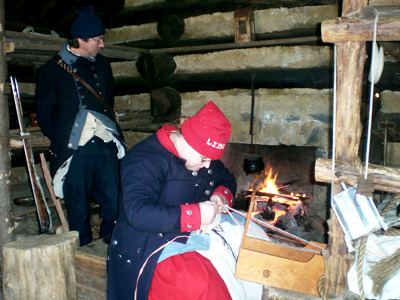 |
Park Ranger Marc Brier tends to the fire, while Park Ranger Quinn Kess demonstrates how women “camp followers” made durable string that would be used to mend clothing. (Photo by Lily Stofman) |
She took a break from making strings that would be used to mend soldier’s clothing and, with their teeth shattering, they huddled close to the fire. Like their Revolutionary War counterparts of more than two centuries ago, both of the re-enactment participants hoped the winter months would soon come to an end and their struggle for independence could at last be achieved.
With all of the options the Philadelphia area provides for visiting historic sites, interested travelers must not pass up the opportunity to spend a day at Valley Forge National Historic Park where Gen. George Washington and his Continental Army troops set up camp from Dec. 19, 1777, to June 19, 1778, during the Revolutionary War.
Valley Forge offers a plethora of daily activities for its visitors, such as re-enactments and guided tours. The knowledge of the park rangers can keep even a non-history buff entranced in their stories for hours.
| Park Rangers Marc Brier and Quinn Kess are dressed as a soldier and “camp follower” inside a hut at the Muhlenberg Brigade (Photo by Lily Stofman). |
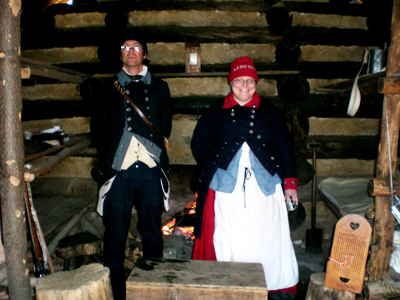 |
On that particular day, Park Ranger Graham Dellinger, who was working at the park’s Welcome Center, recommended to start the tour at the site of the Muhlenberg Brigade, where replicated huts mark the place where Gen. Peter Muhlenberg’s Brigade anchored the outer line of defense during the army’s winter stay at Valley Forge.
Park Rangers Kess and Brier, who were dressed in wardrobe of the time, discussed the role of women in the Revolutionary War, as it was there, at the Muhlenberg Brigade, where men, women “camp followers,” and children resided.
“There is so little focus on women in that time,” said Dellinger. “But they had such important roles. Have you ever heard of Molly Pitcher?”
Molly Pitcher, whose real name was Mary Hays McCauly, got her nickname while enduring the army life with her husband, William Hays. After spending a frigid six months at Valley Forge and dealing with shortages of food, clothing and equipment, the Continental Army moved on to fight at the Battle of Monmouth on June 28, 1778.
As cold as Valley Forge was that winter, Monmouth was hot and Molly Pitcher took on the role of fetching pitchers of water to cool the men’s guns and ease their dehydrated throats, hence how she received her nickname.
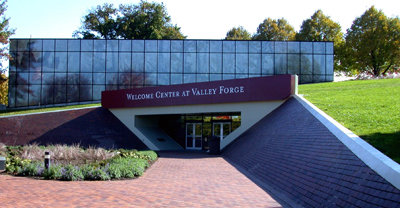 |
The Welcome Center at Valley Forge National Historic Park (Photo courtesy of Valley Forge National Historic Park). |
“I had no idea, women had such a vital role in the army,” said Cyrus Girson, a visitor from Pittsburgh. “When I think of the Revolutionary War, only men come to mind.”
However, women did in fact play a very important role in the war but are often times ignored in history books.
“Women who followed the army were usually the wives of men who were fighting in battle,” said Kess. “They followed the army because they couldn’t sustain themselves back at their farm or house without their husbands.”
However, it wasn’t only the women who could not stand to be away from their husbands. The men too, could not bear to leave their wives for years at a time without thoughts of desertion.
Women would cook, clean, wash and mend clothes, and also nurse their husbands and other men back to health when wounded during battle. They would also take care of their children who were there as well.
Documents show that, along with the 11,000 men camped at Valley Forge, about 400 women were also there based on the rations of food that were designated and recorded each day. It is also speculated that over the course of the eight-year war over thousands of women accompanied the soldiers.
“Women had to go through a lot of the same stuff as men, if not more,” said Peter Maugle, a park ranger at Valley Forge. “I have a lot of respect for them. They had to care for their kids and do everything else.”
| Replicated huts where soldiers, women “camp followers,” and children resided during their six-month stay at Valley Forge (Photo by Lily Stofman). |
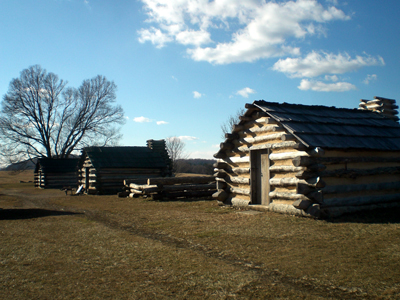 |
Although women took on valuable roles for the soldiers and army as a whole, Washington found them to be a nuisance to his tactics.
“George Washington didn’t like camp followers and he set up a lot of regulations for them,” said Kess. “But he eventually realized that they were a morale boost because the soldiers didn’t have to worry about their wives and their well-being.”
Washington definitely didn’t give any special treatment to the women during the war. In fact, they were given the same treatment as the soldiers. For instance, Washington mandated that women and children were not to ride in wagons; they were to walk with everyone else. They were also given the same food rations and the same type of shelter.
On the other hand, officers wives and Martha Washington were given very special treatment. Stationed in or around Gen. Washington’s headquarters, about a mile from the Muhlenberg Brigade, upper class women did not feel the same effects of war as the “camp followers.”
Most upper class women only stayed with the army during the winter months when the army was stationed at one location and not when the army was traveling during the warmer months. They also did not have to do manual labor like the other “camp followers” because the wealthy families had slaves or servants to do cooking, cleaning and mending.
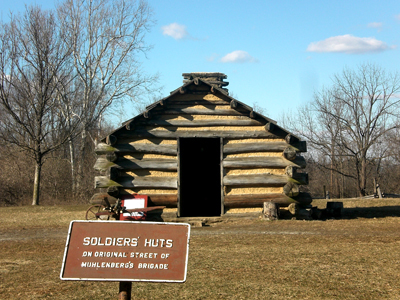 |
A hut at Muhlenberg’s Brigade where men, women “camp followers,” and children resided during their six-month stay at Valley Forge (Photo by Lily Stofman). |
“Martha’s role was to be a lady and to create a sense of home,” said Kess. “She also did a lot of entertaining for dignitaries and other generals and their wives.”
In a sense, Martha Washington, too, was crucial to the war efforts because she kept up the morale of her husband and other officers by taking their minds off the war, if only for a moment.
Even though the difference in social class separated Martha Washington both literally and figuratively from the other “camp followers,” they both endured similar hardships while away from home and on the battlefield.
Making history, the men played a vital role in the war efforts, but many would argue that without the supportive presence of women, the success that was achieved might not have been possible.
If You Go
- Park grounds are open daily, year round from 6 a.m. to 10 p.m.
- The Welcome Center is open daily from 9 a.m. to 5 p.m., but is closed Thanksgiving, Christmas, and New Year’s Day.
-
Daily activities include: biking, hiking, riding horses, taking tours, exploring the museum, watching reenactments, speaking with interpreters and visiting the buildings and monuments around the park.
- For information about daily activities and planning your visit:
- Call the Welcome Center at 610-783-1077 or visit http://www.nps.gov/vafo/.
- Pets are welcome but must be on a leash and owner must clean up after pet.
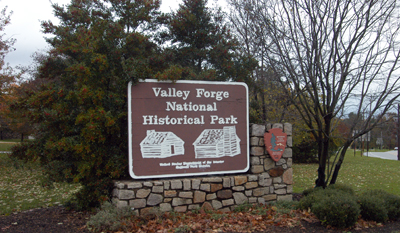 Valley Forge National Historic Park is located at 1400 N. Outer Line Dr., King of Prussia, PA 19406.
Valley Forge National Historic Park is located at 1400 N. Outer Line Dr., King of Prussia, PA 19406.- Directions from Philadelphia, New Jersey and points southeast, via I-76 Schuylkill Expressway west: Take I-76 Schuylkill Expressway west to Exit 328A.Stay Right and merge onto U.S. 422 west. Then, take the Valley Forge exit onto Route 23 west. Turn right at the exit ramp and merge to the center lane. The park entrance is straight through the first set of traffic lights (at intersection with North Gulph Road).
- Philadelphia area attractions: Independence National Historical Park, Gettysburg National Military Park, Steamtown National Historic Site, Hopewell Furnace National Historic Site and the Delaware Water Gap National Recreation Area.

Comments are Closed